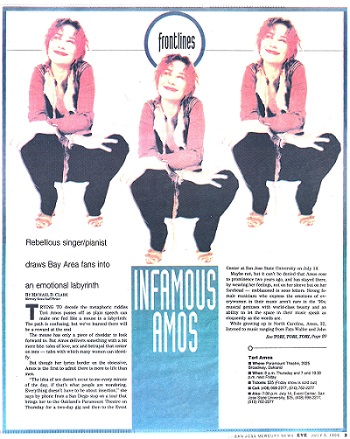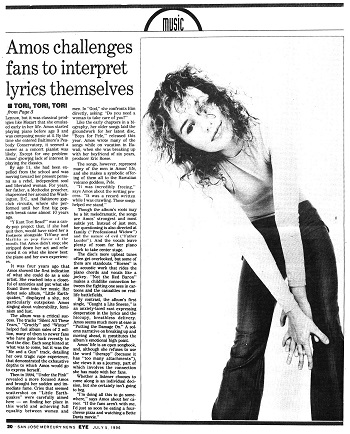|

songs | interviews | photos | tours | boots | press releases | timeline
San Jose Mercury News (US)
July 5, 1996
INFAMOUS AMOS
Rebellious singer/pianist draws Bay Area fans into an emotional labyrinth
by Michael D. Clark
Mercury News Staff Writer
Trying to decode the metaphoric riddles Tori Amos passes off as plain speech can make one feel like a mouse in a labyrinth: The path is confusing, but we've learned there will be a reward at the end.
The mouse has only a piece of cheddar to look forward to. But Amos delivers something with a bit more bite: tales of love, sex and betrayal that center on men -- tales with which many women can identify.
But though her lyrics border on the obsessive, Amos is the first to admit there is more to life than men.
"The idea of sex doesn't occur to me every minute of the day, if that's what people are wondering. Everything doesn't have to be about insertion," she says by phone from a San Diego stop on a tour that brings her to Oakland's Paramount Theatre on Thursday for a two-day gig and then to the Event Center at San Jose State University on July 14.
Maybe not, but it can't be denied that Amos rose to prominence two years ago, and has stayed there, by wearing her feelings, not on her sleeve but on her forehead -- emblazoned in neon letters. Strong female musicians who express the emotions of everywomen in their music aren't rare in the '90s; musical geniuses with world-class beauty and an ability to let the space in their musoc speak as eloquently as the words are.
While growing up in North Carolina, Amos, 32, listened to music ranging from Fats Waller and John Lennon, but it was classical prodigies like Mozart that she emulated early in her life. Amos started playing piano before age 3 and was composing music at 4. By the time she entered Baltimore's Peabody Conservatory, it seemed a career as a concert pianist was likely. Except for one problem: Amos' growing lack of interest in playing the classics.
By age 11, she had been expelled from the school and was moving toward her present persona as a rebel, independent soul and liberated woman. For years, her father, a Methodist preacher, chaperoned her around the Washington, D.C., and Baltimore gay-club circuits, where she performed until her first big pop-rock break came almost 10 years ago.
"Y Kant Tori Read?" was a candy-pop project that, if she had quit then, would have rated her a footnote alongside Tiffany and Martika as pop flavor of the month. But Amos didn't stop; she stripped down her act and refocused it on what she knew best: the piano and her own experiences.
It was four years ago that Amos showed the first indication of what she could do as a solo artist. She reached into a closetful of anxieties and put what she found there into her music. Her debut solo album, "Little Earthquakes," displayed a shy, not particularly outspoken Amos singing about vulnerability, feminism and lust.
The album was a critical success. The tracks "Silent All These Years," "Crucify" and "Winter" helped fuel album sales of 2 million, many of them to newer fans who have gone back recently to find the disc. Each song hinted at what was to come, but it was the "Me and a Gun" track, detailing her own tragic rape experience, that demonstrated the exhaustive depths to which Amos would go to express herself.
Then in 1994, "Under the Pink" revealed a more focused Amos and brought her sudden and immediate fame. Cries that seemed scattershot on "Little Earthquakes" were carefully aimed here -- on finding her place in this world and achieving full equality between women and men. In "God," she confronts Him directly, asking: "Do you need a woman to take care of you?"
Like the early chapters in a biography, her older songs laid the groundwork for her latest disc, "Boys for Pele," released this year. Amos wrote many of the songs while on vacation in Hawaii, when she was breaking up with her boyfriend of six years, producer Eric Rosse.
The songs, however, represent many of the men in Amos' life, and she makes a symbolic offering of them all to the Hawaiian volcano goddess, Pele.
"It was incredibly freeing," says Amos about the writing process. "It was a record written while I was crawling. Those songs helped me stand."
Though the album's roots may be a bit melodramatic, the songs are Amos' strongest and most subtle yet. Instead of just men, her questioning is also directed at family ("Professional Widow") and the nature of evil ("Father Lucifer"). And the vocals leave plenty of room for her piano work to take center stage.
The disc's less upbeat tunes often get overlooked, but some of them are standouts: "Horses" is an acoustic work that rides the piano chords and vocals like a jockey. "Not the Red Baron" makes a childlike connection between the fighting one sees in cartoons and the casualties in real-life battlefields.
By contrast, the album's first single, "Caught a Lite Sneeze," is an anxiety-laced rant expressing desperation in the lyrics and the hiccupy, breathless delivery. Amos seems much more at ease in "Putting the Damage On." A solemn narrative on breaking up and moving ahead, it constitutes the album's emotional high point.
Amos' life is an open songbook, and, although she refuses to use the word "therapy" (because it has "too many attachments"), she views it as a journey, part of which involves the connection she has made with her fans.
Whether a listener chooses to come along is an individual decision, but she certainly isn't going to beg.
"I'm doing all this to go somewhere," says Amos about her career. "If the fans aren't with me, I'd just as soon be eating a four-cheese pizza and watching a Bette Davis movie."
original article


t o r i p h o r i a
tori amos digital archive
yessaid.com
|